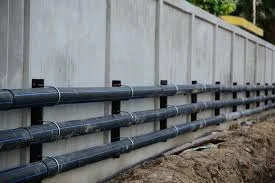Novemba . 19, 2024 04:55 Back to list
Essential Components for Drain Pipe Installation and Maintenance Guide
Understanding Drain Pipe Fittings A Comprehensive Guide
When it comes to plumbing, the importance of proper drainage cannot be overstated. A key component in ensuring efficient drainage systems is the use of appropriate drain pipe fittings. These fittings serve critical functions in connecting pipes, changing the direction of flow, and adjusting pipe diameters. This article will explore the various types of drain pipe fittings, their applications, and tips for installation and maintenance.
Types of Drain Pipe Fittings
1. Elbows Elbows are used to change the direction of the pipe run. They come in various angles, including 45 and 90 degrees. The choice between a 45-degree elbow and a 90-degree elbow depends on the specific plumbing system requirements. The smoother the curve, the less resistance there will be in the flow of water, making 45-degree elbows often preferred in longer runs.
2. Tees Tee fittings are essential when a branch line is needed to connect to the main drain line. They are shaped like the letter “T”, allowing water to flow in three directions. Installing a tee fitting properly is crucial to ensure that each part of the system is functioning well without causing blockages.
3. Adapters Adapters play a vital role in connecting two pipes of different diameters or materials. For instance, you might need to connect a PVC pipe to a cast iron one, and an adapter provides a seamless join to prevent leaks. Compatibility with both pipe sizes is essential when selecting an adapter.
4. Caps and Plugs Sometimes, plumbing systems require a closing off of pipe ends. Caps are used on the end of a pipe to close it off completely, while plugs can also be used but are generally threaded for added security. These fittings are particularly useful during the construction phase or maintenance as they prevent water from flowing through temporarily.
5. Wyes Similar to tees, wye fittings facilitate the connection of a branch line to the main line but allow for a smoother transition, which can significantly reduce the risk of clogs. This is especially important in systems that handle larger volumes of wastewater.
6. Cleanouts Cleanout fittings offer access points to the drainage system for the purpose of cleaning and maintenance. Positioned at strategic junctions in the system, cleanouts enable plumbers to clear clogs without having to dismantle extensive lengths of piping.
Material Considerations
drain pipe fittings

Drain pipe fittings come in a variety of materials, each with its own advantages and disadvantages
- PVC (Polyvinyl Chloride) Widely used in residential plumbing systems, PVC is lightweight, resistant to corrosion, and easy to install. It is ideal for drain, waste, and vent (DWV) systems. - ABS (Acrylonitrile Butadiene Styrene) Similar to PVC, ABS is typically used in drainage systems. It is less brittle than PVC and can be a better option in colder climates where pipes are prone to cracking.
- Cast Iron Known for its durability, cast iron fittings are often used in commercial plumbing and in older homes. They provide excellent sound dampening but can be more challenging to install and require specialized tools.
- Copper While more commonly used for supply lines, copper fittings can also be employed in drainage systems
. They offer longevity and resistance to corrosion but have a higher cost.Installation and Maintenance Tips
Proper installation of drain pipe fittings is crucial for ensuring a well-functioning drainage system
- Measurements Always measure accurately before cutting pipes and choosing fittings to ensure a perfect fit. - Deburring After cutting pipes, deburr the edges to avoid rough spots that can lead to leaks.
- Sealing Use appropriate sealing methods such as plumber's tape or adhesive where necessary to prevent leaks.
- Regular Inspections Regularly inspect the entire drainage system for signs of wear or blockage, especially at connection points where fittings are used.
In summary, drain pipe fittings are vital components of any plumbing system, ensuring an effective drainage solution while preventing potential issues such as clogs and leaks. Understanding the various types of fittings and their applications, alongside proper installation and maintenance techniques, can greatly enhance the longevity and functionality of your drainage system. Whether you are a professional plumber or a DIY enthusiast, taking the time to comprehend these elements will lead to more effective plumbing solutions.
-
Transparent PVC Pipe: Clear Flexible Tubing for Fluids
NewsAug.09,2025
-
Durable PP Rigid Sheet: Versatile & High-Quality Plastic Panels
NewsAug.08,2025
-
Premium Glossy PP Rigid Sheet – Durable & Versatile
NewsAug.07,2025
-
High-Quality HDPE Sheet | Durable Plastic Panels
NewsAug.06,2025
-
High-Precision PVC Rigid Sheets for Vacuum Forming | AI-Optimized
NewsAug.05,2025
-
Durable PVC-M Water Supply Pipes | 60-Year Life
NewsAug.04,2025

